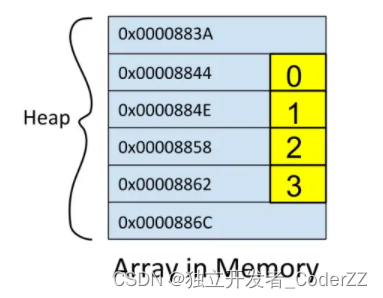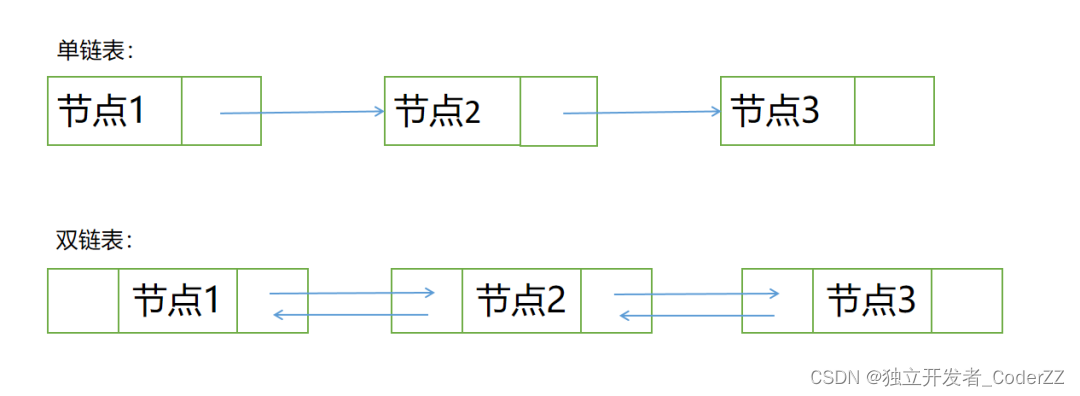-
数据结构小记【Python/C++版】——链表篇
一,基础概念
链表是一种线性表结构,节点是链表中的基本单元。
链表是节点的集合,节点可以分布在内存中的任何位置,每个节点都存储着链表中下一个节点的地址。
如图,看似随意摆放的各个节点,其内部其实有链表维持的相对位置信息。

我们用“指针”来表示链表中的方向,为了维持节点之间的先后顺序,链表给每个节点都附加了一个指针。单链表中的每个节点都包含指向后一个节点的后向指针,双链表中的每个节点不仅包含指向后一个节点的后向指针,也包含指向前一个节点的前向指针。链表在内存上不一定是连续分布的,我们只能沿着指针的方向迭代遍历链表上的节点,无法直接根据下标来访问链表指定位置上的元素。
链表和数组相比,主要优势:
1.链表在编译期不需要知道具体大小。
2.数组中的元素在内存中是连续分布的,且以相同距离间隔开。因此,往数组中插入新的元素就需要移动数组中的其他数据,链表不需要这么麻烦。
数组的内存分布:

链表的内存分布:

二,链表的图示结构
不包含头节点和尾节点的链表:

包含头节点和尾节点的链表:

三,节点的代码表示
以单链表为例,节点的组成:
1,数据域:节点的元素值
2,指针域:指向下一个节点的指针
Python实现:
- class Node:
- def __init__(self, value):
- self.data = value
- self.next = None
C++实现:
- struct Node {
- int value; //节点的元素值,假设存储的元素是int类型
- Node *next; //后向指针
- Node(int val = 0) { value = val; next = NULL; } //构造函数
- };
如果要实现双链表,且用泛型来表示元素值的类型,可以这样实现节点:
- template <typename T>
- struct Node {
- T value; //节点的元素值
- Node *next; //后向指针
- Node *prev; //前向指针
- Node() { next = NULL; prev = NULL; } //默认构造函数
- Node(const T &val) { value = val; next = NULL; prev = NULL; } //初始化元素值的构造函数
- };
四,链表常见操作
1.初始化和使用链表
Python实现:
- class Node:
- def __init__(self, item):
- self.item = item
- self.next = None
- class LinkedList:
- def __init__(self):
- self.head = None
- if __name__ == '__main__':
- linkedList = LinkedList()
- linkedList.head = Node(1)
- second = Node(2)
- third = Node(3)
- #连接各个节点
- linkedList.head.next = second
- second.next = third
- while linkedList.head != None:
- print(linkedList.head.item, end=" ")
- linkedList.head = linkedList.head.next
C++实现:
- #include
- using namespace std;
- class Node {
- public:
- int value;
- Node* next;
- };
- int main() {
- Node* head;
- Node* one = NULL;
- Node* two = NULL;
- Node* three = NULL;
- one = new Node();
- two = new Node();
- three = new Node();
- one->value = 1;
- two->value = 2;
- three->value = 3;
- //连接各个节点
- one->next = two;
- two->next = three;
- three->next = NULL;
- head = one;
- while (head != NULL) {
- cout << head->value << endl;
- head = head->next;
- }
- }
2.链表往后追加节点

Python实现:
- def append(self, new_element):
- current = self.head
- if self.head:
- while current.next:
- current = current.next
- current.next = new_element
- else:
- self.head = new_element
C++实现:
- class Node
- {
- public:
- int data;
- Node* next;
- };
- void append(Node** head_ref, int new_data)
- {
- Node* new_node = new Node();
- Node* last = *head_ref;
- new_node->data = new_data;
- new_node->next = NULL;
- if (*head_ref == NULL)
- {
- *head_ref = new_node;
- return;
- }
- while (last->next != NULL)
- {
- last = last->next;
- }
- last->next = new_node;
- return;
- }
3.链表指定位置添加节点

Python实现:
- def insert(self, new_element, position):
- counter = 1
- current = self.head
- if position > 1:
- while current and counter < position:
- if counter == position - 1:
- new_element.next = current.next
- current.next = new_element
- current = current.next
- counter += 1
- elif position == 1 :
- new_element.next = self.head
- self.head = new_element
C++实现:
- class Node
- {
- public:
- int data;
- Node *next;
- };
- void insert(Node* prev_node, int new_data)
- {
- if (prev_node == NULL) {
- cout << "The given previous node cannot be NULL";
- return;
- }
- Node* new_node = new Node();
- new_node->data = new_data;
- //最核心的两步
- new_node->next = prev_node->next;
- prev_node->next = new_node;
- }
4.获得链表长度
Python实现:
- def getlength(self):
- current = self.head
- count = 0
- while current.next:
- count = count + 1
- current = current.next
- return count
C++实现:
- int getlength(Node* head)
- {
- int count = 0;
- Node* current = head;
- while (current != NULL) {
- count++;
- current = current->next;
- }
- return count;
- }
5.删除指定节点
具体操作: 将前一个节点的next指针指向被删除节点的下一个节点
Python实现:
示意图:

- def delete(self, value):
- current = self.head
- previous = None
- while current.value != value and current.next:
- previous = current
- current = current.next
- if current.value == value:
- if previous:
- previous.next = current.next
- else:
- self.head = current.next
C++实现:
- typedef struct Node {
- int data;
- struct Node* next;
- } Node;
- void delete(Node** head, int position)
- {
- Node* temp;
- Node* prev;
- temp = *head;
- prev = *head;
- for (int i = 0; i < position; i++) {
- if (i == 0 && position == 1) {
- *head = (*head)->next;
- free(temp);
- }
- else {
- if (i == position - 1 && temp) {
- prev->next = temp->next;
- free(temp);
- }
- else {
- prev = temp;
- if (prev == NULL)
- break;
- temp = temp->next;
- }
- }
- }
- }
6.查询某节点是否存在
Python实现:
- def search(self, item):
- current = self.head
- found = False
- while current != None and not found:
- if current.value == item:
- found = True
- else:
- current = current.next()
- return found
C++实现:
- class Node {
- public:
- int data;
- Node* next;
- };
- bool search(Node* head, int x)
- {
- Node* current = head;
- while (current != NULL) {
- if (current->data == x)
- return true;
- current = current->next;
- }
- return false;
- }
五,链表的主要使用场景
如果应用场景包含很多查询操作,此时更适合使用数组。如果应用场景中,需要使用的元素个数不确定,且需要经常对元素进行添加和删除操作,此时使用链表结构会更合适。简单概括就是,链表适合使用在频繁增删的场景,数组适合使用在频繁查询的场景。六,参考阅读
《Problem Solving with Algorithms and Data Structures Using Python, Second Edition》https://www.programiz.com/dsa/linked-listhttps://www.geeksforgeeks.org/what-is-linked-list/?ref=lbphttps://gist.github.com/bavly/ef45e5b9db7d9a400b51ec132f553a0ahttps://pumpkinprogrammerdotcom4.wordpress.com/2014/06/13/c-tutorial-intro-to-linked-lists/ -
相关阅读:
ArcGIS pro 支持 发布三维服务
【预测模型-BP分类】基于人工蜂群算法优化BP神经网络实现数据分类附matlab代码
java毕业设计基于ssm框架的生鲜超市进销存管理系统
我要写整个中文互联网界最牛逼的JVM系列教程 | 「JVM与Java体系架构」章节:JVM的位置
入侵检测---IDS
Vue3 学习笔记
PyTorch官方文档学习笔记(备忘)
任萧文——少年何妨梦摘星?敢挽桑弓射玉衡
DEJA_VU3D - Cesium功能集 之 051-地形开挖完美实现
java中set接口、哈希表、哈希值、HashSet、LinkedHashSet、方法的可变参数
- 原文地址:https://blog.csdn.net/CoderZZ_2024/article/details/136521849
